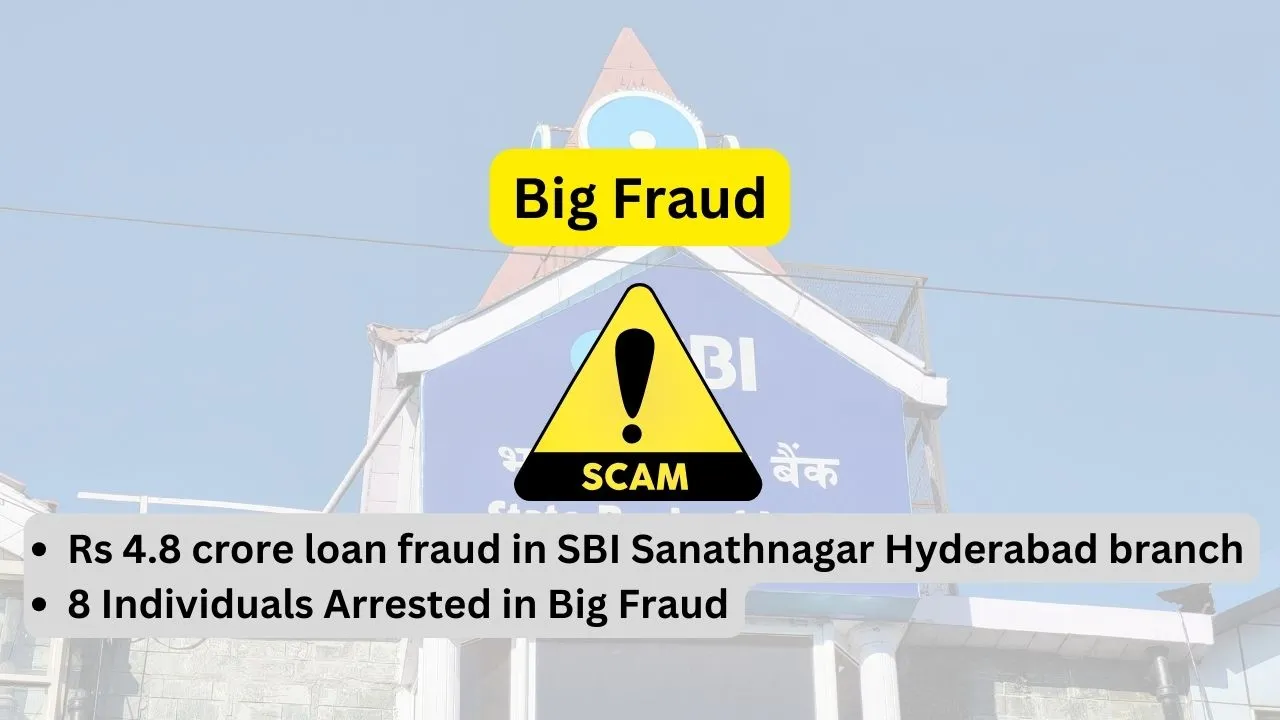SBI Sanathnagar Hyderabad: The Cyberabad Economic Offences Wing (EOW) recently uncovered a significant ₹4.8-crore loan fraud at the Sanathnagar branch of State Bank of India (SBI), leading to the arrest of eight individuals involved in the scheme. The fraud was centered around the manipulation of SBI’s lending process to approve loans based on fraudulent documents, allowing the conspirators to siphon off substantial amounts of money. Below is a detailed breakdown of the fraud and its execution.
Key Figures Arrested in SBI Sanathnagar Hyderabad Branch Scam:
The eight individuals arrested in connection with the loan fraud include:
- Mattepally Srishanth
- Pole Vishal
- Dagala Raju
- Sudhansu Shekhar Parida
- Md. Wajeed
- U. Sunil Kumar
- Bhaskar Goud
- Amanchi Upender
Role of Karthik Rai:
At the heart of the fraud was Karthik Rai, who was the Branch Manager of SBI Sanathnagar. He was arrested by the Sanathnagar Police on May 20 for his involvement in facilitating the fraudulent loans. Rai, in exchange for a 5% commission, used his managerial position to approve loans that were not properly verified. His actions were the catalyst for the large-scale fraud.
How the Fraud Was Uncovered:
The fraud came to light after a formal complaint was lodged by Ramachandra Raghavendra Prasad Paparapatti, the current branch manager at SBI Sanathnagar. Paparapatti discovered discrepancies in the loan approval process, which led to an investigation by the Cyberabad EOW.
The Fraudulent Loan Scheme:
From June 2020 to June 2023, Karthik Rai used his managerial authority to approve loans for applicants who provided falsified documents. These documents included:
- Fake salary slips
- Fake identification cards
In return for these fraudulent approvals, Rai accepted a 5% commission for each loan processed. This practice of approving loans without proper verification allowed the fraud to flourish over the course of three years.
The Fraudulent Loan Process:
- Md. Wajeed, the main mastermind behind the fraud, led the group in securing the fraudulent loans.
- Dagala Raju, a loan agent, worked with Mattepally Srishanth and Pole Vishal, who posed as employees of the Telangana State Residential School and College for Girls. Using these false identities, they were able to obtain loan approvals with the help of the forged documents.
- Sudhansu Shekhar Parida played a critical role in the creation of the fake salary slips and identification cards. These documents were necessary to support the loan applications.
- Amanchi Upender, who operated a Xerox shop in Prakash Nagar, Begumpet, helped in reproducing the forged documents.
- Bhaskar Goud, a stamp maker, provided fake rubber stamps to authenticate the forged salary slips and IDs, further making the documents appear legitimate.
The Loan Approvals and Fund Diversion:
Once the fake documents were submitted, and with Karthik Rai’s approval, the group successfully obtained loans that would not have otherwise been approved under normal circumstances. In total, eight loans were sanctioned amounting to ₹1.02 crore. However, these loans were based on fraudulent applications, and the funds were diverted to third-party accounts through illegal means.
The group took 30% of the loan amount as a commission, which amounted to ₹30 lakh. This money was divided among the conspirators, including Karthik Rai, and then transferred to various third-party accounts, making it difficult to trace the funds back to the loan applicants.
Additional Fraudulent Activities:
Apart from the direct fraudulent loans, Karthik Rai was also involved in further deceitful activities:
- Loan Diversion: Rai misled customers by telling them their existing bank loans were being closed, and new loans would be processed. In reality, he approved new loans and diverted the funds to third parties. These new loans were sanctioned under false pretenses, allowing Rai and his associates to profit further.
- Fixed Deposit Manipulation: Rai also diverted customers’ Fixed Deposit (FD) amounts to third-party accounts. He did this by misleading customers into thinking their FDs were being used for high-profit investments, such as mutual funds, when in fact, the funds were diverted elsewhere.
- Deceptive Practices in the Case of Death: In the event of a customer’s death, Rai further exploited the situation by claiming the funds from the deceased’s account without informing or obtaining consent from the legal heirs of the deceased. This fraudulent claim was made under the false pretext that the loans were being closed or transferred, further extending the fraud.
How the Scheme Was Systematically Carried Out in SBI Sanathnagar Hyderabad:
The group used a well-coordinated operation to exploit SBI’s internal processes. By using a combination of fake documents, misrepresentation, and the involvement of multiple individuals in different roles (loan agents, document forgers, stamp makers, and a branch manager), they were able to create a complex fraud network that lasted for more than three years. They knew how to bypass the bank’s verification processes, making it difficult for authorities to detect the fraud initially.
Conclusion:
This fraud represents a highly organized and systematic scheme to exploit a financial institution for personal gain. The key figure, Karthik Rai, abused his position as the branch manager, while his associates took advantage of the bank’s loan approval process to secure unauthorized loans. Through forged documents, misrepresentation, and illegal fund diversion, the group was able to siphon off ₹4.8 crore.
The investigation is still ongoing, and the police are working to trace the remaining funds and uncover the full extent of the fraud. The involvement of various individuals in different roles underscores the complexity of the operation and the degree to which the group was able to manipulate the system.
